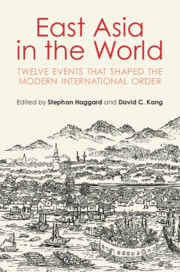Book contents
- East Asia in the World
- East Asia in the World
- Copyright page
- Contents
- Figures and Tables
- Contributors
- Acknowledgments
- Part I Historicizing East Asian International Relations
- Part II The East Asian System over Time
- 4 East Asia’s First World War, 643–668
- 5 The Founding of the Korean Chosŏn Dynasty, 1392
- 6 The Ming Invasion of Vietnam, 1407–1427
- 7 Ming Grand Strategy during the Great East Asian War, 1592–1598
- 8 The Qing Unification, 1618–1683
- Part III Contact: East and West
- Conclusion
- Bibliography
- Index
8 - The Qing Unification, 1618–1683
from Part II - The East Asian System over Time
Published online by Cambridge University Press: 08 October 2020
- East Asia in the World
- East Asia in the World
- Copyright page
- Contents
- Figures and Tables
- Contributors
- Acknowledgments
- Part I Historicizing East Asian International Relations
- Part II The East Asian System over Time
- 4 East Asia’s First World War, 643–668
- 5 The Founding of the Korean Chosŏn Dynasty, 1392
- 6 The Ming Invasion of Vietnam, 1407–1427
- 7 Ming Grand Strategy during the Great East Asian War, 1592–1598
- 8 The Qing Unification, 1618–1683
- Part III Contact: East and West
- Conclusion
- Bibliography
- Index
Summary
Traditional Chinese and English historiography regards 1644 as the year of the Qing conquest of China, though most historians regard this as a shorthand for collapsing the long and complex process by which the Ming empire in China disintegrated and the Qing empire in southern Manchuria expanded to include China. However, by dismantling the concept of the Qing conquest of China as an event, and instead looking at the coterminous processes affecting political coherence across Mongolia, Manchuria, and China, the Qing conquest of Ming China emerges as a reunification of historical Chinese territories that had been fragmented by various forces in the late sixteenth and early seventeenth centuries. Though attention in examining the Ming–Qing transition is usually directed toward the China borders with Mongolia and Manchuria, this essay proposes that the best geographical theatre for tracing these changes lies in Yunnan province, in southwest China.
- Type
- Chapter
- Information
- East Asia in the WorldTwelve Events That Shaped the Modern International Order, pp. 129 - 146Publisher: Cambridge University PressPrint publication year: 2020

